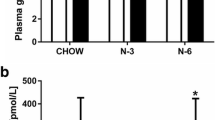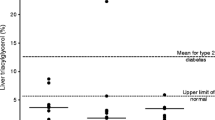Abstract
Acute elevation of plasma free fatty acid (FFA) levels causes insulin resistance to rise dose dependently in pregnant and nonpregnant women. Plasma FFA levels are commonly elevated during late pregnancy, partly due to rising blood levels of lipolytic placental hormones, and are a likely cause for much of the increase in insulin resistance occurring at that time in all pregnant women. Plasma FFA levels are similar or higher and the insulin resistance is comparable or more severe in women with gestational diabetes mellitus (GDM) than in nondiabetic pregnant women. In contrast to healthy pregnant women, insulin secretion in women with GDM is defective and, therefore, is unable to rise adequately to compensate for the insulin resistance; the result is hyperglycemia. The mechanism by which elevated plasma FFA levels cause insulin resistance in skeletal muscle includes intramyocellular accumulation of diacylglycerol, which activates protein kinase C (the β II and δ isoforms). This results in reduction of tyrosine phosphorylation of the insulin receptor substrate-1 and inhibits activation of phosphoinositol-3 kinase, an enzyme that is essential for normal insulin-stimulated glucose uptake.
Similar content being viewed by others
References and Recommended Reading
Homko CJ, Cheung P, Boden G: Effects of free fatty acids on glucose uptake and utilization in healthy women. Diabetes 2003, 52:487–491. Shows that elevation of plasma FFAs causes acute insulin resistance in healthy young women similar to FFA-induced insulin resistance in healthy young men.
Boden G, Jadali F, White J, et al.: Effects of fat on insulin-stimulated carbohydrate metabolism in normal men. J Clin Invest 1991, 88:960–966.
Boden G, Chen X, Ruiz J, et al.: Mechanisms of fatty acidinduced inhibition of glucose uptake. J Clin Invest 1994, 93:2438–2446.
Roden M, Price TB, Perseghin G, et al.: Mechanisms of free fatty acid induced insulin resistance in humans. J Clin Invest 1996, 17:2859–2865.
Frias JP, Maaraeg GB, Ofrecio J, et al.: Decreased susceptibility to fatty acid-induced peripheral tissue insulin resistance in women. Diabetes 2001, 50:1344–1350.
Santomauro A, Boden G, Silva M, et al.: Overnight lowering of free fatty acids with acipimox improves insulin resistance and glucose tolerance in obese diabetic and non-diabetic subjects. Diabetes 1999, 48:1836–1841.
Boden G: Fuel metabolism in pregnancy and in gestational diabetes. Obstet Gynecol North Am 1996, 23:1–10.
Phelps RL, Metzger BE, Freinkel N: Carbohydrate metabolism in pregnancy XVII. Diurnal profiles of plasma glucose, insulin, free fatty acids, triglycerides, cholesterol, and individual amino acids in late normal pregnancy. Am J Obstet Gynecol 1981, 140:730–736.
Hubel CA, McLaughlin MK, Evans RW, et al.: Fasting serum triglycerides, free fatty acids, and malondialdehyde are increased in preeclampsia, are positively correlated, and decrease within 48 hours postpartum. Am J Obstet Gynecol 1996, 174:975–982.
Hauguel S, Gilbert M, Girard J: Pregnancy-induced insulin resistance in liver and skeletal muscles of the conscious rabbit. Am J Physiol 1987, 252: E165-E169.
Gilbert M, Basile S, Baudelin A, Pere AMC: Lowering plasma free fatty acid levels improves insulin action in conscious pregnant rabbits. Am J Physiol 1993, 264:E576-E582.
Sivan E, Homko CJ, Whittaker PG, et al.: Free fatty acids and insulin resistance during pregnancy. J Clin Endocrinol Metab 1998, 83:2338–2342.
Sivan E, Chen X, Homko CJ, et al.: A longitudinal study of carbohydrate metabolism in healthy, obese pregnant women. Diabetes Care 1997, 20:1470–1475.
Catalano PM, Tyzibir ED, Roman NM, et al.: Longitudinal changes in insulin resistance in non-obese pregnant women. Am J Obstet Gynecol 1991, 165:1667–1772.
Beck P, Daughaday WH: Human placental lactogen: studies of its acute metabolic effects and disposition in normal man. J Clin Invest 1967, 46:103–110.
Turtle JR, Kipnis DM: The lipolytic action of human placental lactogen in isolated fat cells. Biochim Biophys Acta 1967, 144:583–593.
Sivan E, Chen X, Homko CJ, et al.: The effect of insulin on fat metabolism during and after normal pregnancy. Diabetes 1999, 48:834–838.
Buchanan TA, Catalano PM: The pathogenesis of GDM: implication for diabetes after pregnancy. Diabetes 1995, 3:584–601.
Boden G: Obesity, free fatty acids and insulin resistance. Curr Opin Endocrinol Diabetes 2001, 8:235–239.
Ryan EA, O'Sullivan MJ, Skyler JS: Insulin action during pregnancy: studies with the euglycemic clamp technique. Diabetes 1985, 34:380–389.
Kautzky-Willer A, Prager R, Waldhausl W, et al.: Pronounced insulin resistance and inadequate beta-cell secretion characterize lean gestational diabetes during and after pregnancy. Diabetes Care 1997, 20:1717–1723.
Bowes SB, Hennessy TR, Umpleby AM, et al.: Measurement of glucose metabolism and insulin secretion during normal pregnancy and pregnancy complicated by gestational diabetes. Diabetologia 1996, 39:976–983.
Xiang AH, Peters RK, Trigo E, et al.: Multiple metabolic defects during late pregnancy in women at high risk for type 2 diabetes. Diabetes 1999, 48:848–885.
Catalano PM, Drago NM, Amini SB: Longitudinal changes in pancreatic beta-cell function and metabolic clearance rate of insulin in pregnant women with normal and abnormal glucose tolerance. Diabetes Care 1998, 21:403–408.
Buchanan TA, Metzger BE, Freinkel N, Bergman RN: Insulin sensitivity and beta-cell responsiveness to glucose during late pregnancy in lean and moderately obese women with normal glucose tolerance or mild gestational diabetes. Am J Obstet Gynecol 1990, 162:1008–1014.
Homko C, Sivan E, Chen X, et al.: Insulin secretion during and after pregnancy in patients with gestational diabetes mellitus. J Clin Endocrinol Metab 2001, 86:568–573. Illustrates that women with GDM have defects in insulin secretion and action, both of which improve postpartum.
Catalano PM, Nizielski SE, Shao J, et al.: Downregulated IRS-1 and PPARgamma in obese women with gestational diabetes: relationship to FFA during pregnancy. Am J Physiol 2002, 282:E522-E533.
Boden G, Chen X: Effects of fat on glucose uptake and utilization in patients with non-insulin dependent diabetes. J Clin Invest 1995, 96:1261–1268.
Itani SI, Ruderman NB, Schmieder F, Boden G: Lipid-induced insulin resistance in human muscle is associated with changes in diacylglycerol, protein kinase C, and IkappaBalpha. Diabetes 2002, 51:2005–2011. Demonstrates that acute FFA-induced insulin resistance is associated with intramyocellular accumulation of DAG and activation of PKC β II and δ.
Ravichandran LV, Esposito DL, Chen J, Quon MJ: Protein kinase C-zeta phosphorylates insulin receptor substrate-1 and impairs its ability to activate phosphatidylinositol 3-kinase in response to insulin. J Biol Chem 2000, 276:3543–3549.
Dresner A, Laurent D, Marcucci M, et al.: Effects of free fatty acids on glucose transport and IRS-1-associated phosphatidylinositol 3-kinase activity. J Clin Invest 1999, 103:253–259.
Saltiel AR, Kahn R: Insulin signaling and the regulation of glucose and lipid metabolism. Nature 2001, 414:799–806.
Borkman M, Storlien LH, Pan DA, et al.: The relation between insulin sensitivity and the fatty-acid composition of skeletalmuscle phospholipids. N Engl J Med 1993, 328:238–244.
Hawkins M, Barzilai N, Liu R, et al.: Role of the glucosamine pathway in fat-induced insulin resistance. J Clin Invest 1997, 99:2173–2182.
Long SD, Pekala PH: Regulation of Glut4 gene expression by arachidonic acid: evidence for multiple pathways, one of which requires oxidation to prostaglandin E2. J Biol Chem 1996, 271:1138–1144.
Gastaldelli A, Toschi E, Pettiti M, et al.: Effect of physiological hyperinsulinemia on gluconeogenesis in nondiabetic subjects and in type 2 diabetic patients. Diabetes 2001, 50:1807–1812.
Edgerton DS, Carin S, Emshwiller M, et al.: Small increases in insulin inhibit hepatic glucose production solely caused by an effect of glycogen metabolism. Diabetes 2001, 50:1872–1882.
Boden G, Cheung P, Stein TP, et al.: FFA cause hepatic insulin resistance by inhibiting insulin suppression of glycogenolysis. Am J Physiol 2002, 283:E12-E19.
Lam TKT, Yoshi H, Haber A, et al.: Free fatty acid-induced hepatic insulin resistance: a potential role for protein kinase C-delta. Am J Physiol 2002, 283:E682-E691.
Crespin SR, Greenough WB, Steinberg D: Stimulation of insulin secretion by long-chain free fatty acids. J Clin Invest 1973, 52:1979–1984.
Boden G, Chen X, Rosner J, et al.: Effects of a 48-hour fat infusion on insulin secretion and glucose utilization. Diabetes 1995, 44:1239–1242.
Boden G, Chen X, Iqbal N: Acute lowering of plasma fatty acids lowers basal insulin secretion in diabetic and nondiabetic subjects. Diabetes 1998, 47:1609–1612.
Hirose H, Lee YH, Inman LR, et al.: Defective fatty acid mediated beta-cell compensation in Zucker diabetic fatty rats. J Biol Chem 1996, 271:5633–5637.
Author information
Authors and Affiliations
Rights and permissions
About this article
Cite this article
Sivan, E., Boden, G. Free fatty acids, insulin resistance, and pregnancy. Curr Diab Rep 3, 319–322 (2003). https://doi.org/10.1007/s11892-003-0024-y
Issue Date:
DOI: https://doi.org/10.1007/s11892-003-0024-y




